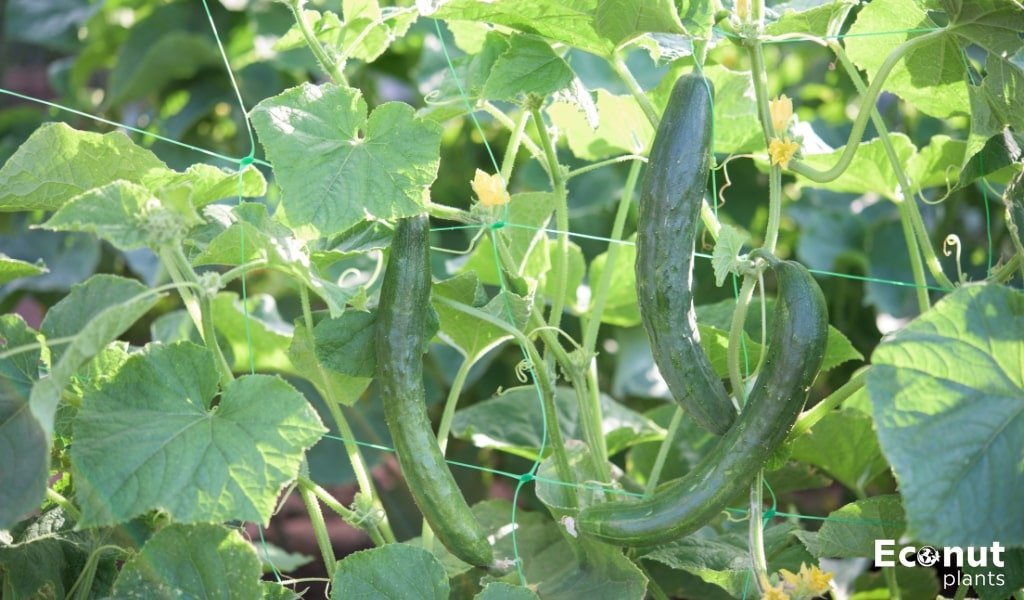You, as a gardener, can benefit from companion planting in many ways. In companion planting, vegetable plants typically have higher disease and insect resistance. Better biodiversity and a supply of food and habitat for a multitude of species are two additional benefits of having stronger plants in the bed.
This article explains which plants are good companions for cucumber plants. Also included are suggestions for plants that shield cucumbers from mildew.
Cucumber Companion Planting Benefits
Planting particular species together for reciprocal advantages is known as companion planting, and it’s an ancient strategy. This type of symbiosis increases the garden’s resilience and biodiversity to the fullest.
Polycultures, as opposed to monocultures, which are huge plantings of a single crop, use companion plants to imitate natural ecosystems in which a multitude of plants cooperate to support the growth of one another.
Companion crops can reduce pest and disease pressure and drastically enhance yields, especially for cucumbers. Cucumbers can be used with other flowers, herbs, and vegetables to help:
Attract Pollinators
Most cucumber varieties need sufficient pollination to produce an abundant fruit set. Without pollinated flowers, there can be no fruits! Sometimes, though, there aren’t enough cucumber blossoms to attract enough bees to produce extremely large crops.
Symbiotic flowers offer an additional nectar supply that will make the cucumber patch buzz. A bonus that you get to enjoy is gorgeous bursts of colour and maybe even some butterflies!
Weed Suppression
Cucumbers usually compete reasonably effectively with weeds because of their large, flat leaves. Companion plants that control weeds and develop slowly can provide an additional layer of support, though. These plants preserve moisture, insulate the soil, and serve as ground cover to keep weeds at bay.
Save Space and Maximize Yields
Gardeners strive to produce as much tasty food as they can in the smallest amount of area and with the least amount of work.
By pairing edible plants with your cucumbers, companion plants help you utilize portions of your garden that could have otherwise remained unusable.
Attract Beneficial Insects
Many companion plants attract beneficial insects by acting as insects. To control pest populations, they aid in the creation of a dynamic environment around your cucumber beds by drawing in predatory insects.
Particularly useful are certain herbs and flowers that attract ladybirds, lacewings, parasitic wasps, and spiders that consume all the pesky critters that eat cucumbers.
Living Trellis
Certain plants work as live trellis when combined with cucumbers, adhering to the methods of old-time traditional farming. Cucumber vines can wind up their stems and stay upright thanks to these robust stalks, preventing fruits from decaying in the ground.
Although this type of companion planting requires more preparation, when done right, it may provide an amazing natural ecosystem.
Attract Pollinators
Proper pollination is necessary for an abundant fruit set in the majority of cucumber types. There can be no fruits if there are no pollinated flowers! Unfortunately, sometimes the number of bees required for exceptionally high yields cannot be attracted by cucumber blossoms alone.
To get the cucumber patch buzzing with activity, symbiotic flowers provide an alternate supply of nectar. Beautiful bursts of colour and perhaps even some butterflies are an extra treat that you appreciate!
Repel Pests
The primary motivation behind companion planting is to deter pests. Certain herbs and flowers have a fragrance that keeps hungry insects like spider mites, aphids, cucumber beetles, and thrips away.
Mistakes to Avoid
Any gardener can attest to the enjoyment and excitement of symbiotic plantings. You get to play with building your distinct environment teeming with a bountiful harvest of vegetables, herbs, and flowers! With companion planting, it is possible to become a little too enthusiastic.
Steer clear of these typical blunders to make sure your companion plants benefit your cucumbers instead of unintentionally stunting their growth:
Competition for Water
Cucumbers and other crops with shallow roots find it more difficult to cling to water. Make sure that deep-rooted vegetables or herbs won’t unintentionally deplete your cucumbers’ moisture when selecting companion plants. Mulches are an excellent technique to keep water in the soil for each plant in the bed.
Shading Out Your Crop
If one plant overgrows and crowds out the other, most of the benefits of a symbiotic plantain are eliminated. Make sure that companion plants don’t grow a shadowy canopy over cucumber vines that are creeping along the ground.
Trellising or low-growing companions are excellent strategies to keep cucumbers in the sunshine, as most garden vegetables require full sun.
Not Enough Spacing
It’s crucial to watch out that companion plants don’t unintentionally invade your cucumbers’ personal space because nobody likes being crowded. A plant’s mature size should always be taken into account, as should the distance it needs to be from the crop to have enough airflow and room to thrive.
Competition for Nutrients
Cukes require a lot of fertility to produce luscious fruits all summer long because they are moderate-to-heavy feeders. Make sure the soil is sufficiently fertile to support both your cucumber plants and those of your neighbours.
17 Cucumber Companion Plants
1. Corn

Cucumbers and corn make one of the most unusual garden combinations. In addition, the dense canopy that the cucumbers and corn together produce helps to keep weeds at bay and provides some shade for the cucumbers during the summer heat.
In essence, the same amount of space yields twice as much produce, this planting is a fantastic method to teach kids about how plants can cooperate in natural ecosystems, and looks extremely cool.
Benefits: Weed suppression, summer shade, and living trellis.
How to Plant It: Give the cucumbers enough time to grow their stalks by planting those two weeks after you straight-seed the corn. The cucumber seeds should be spaced either in between each row of corn or exactly 12″ away from the corn rows.
Start teaching the cucumber vines to climb the stalks by winding their tips around the base of the corn when it is at least two to three feet tall. Since they are both heavy feeder crops, make sure there is an abundance of fertility available.
2. Radishes

Radishes, one of the veggies that grow the fastest, make an excellent partner for cucumbers since they may be harvested before the cucumbers start to outgrow them. Although radishes don’t always help cucumbers grow, they do bring more variety to the bed and allow you to harvest more from the same area.
Benefits: Make the most of the harvestable space.
How to Plant It: Plant young cucumber plants and sow radish seeds in a 6-inch row from them. Space each radish apart by 4–6 inches. While the cucumbers have plenty of room to grow, the radishes will be ready to be pulled in approximately 30 days.
3. Beets

You may also place beets or other root vegetables next to cucumbers to maximize the amount of room. Their bulbous, spherical roots gently loosen the soil while adding variation to the bed.
Benefits: maximizes harvestable space and loosens the soil.
How to Plant It: Plant beets 6–12 inches up from the trellis base in a row when transplanting cucumbers. To achieve consistent germination, space seedlings 1 to 2 inches apart and make sure each seed has its drip watering connection.
Cucumbers should start to shade beets when they are ready to be harvested. This combo is not recommended if you are vining cucumbers on the ground.
4. Sweet Alyssum
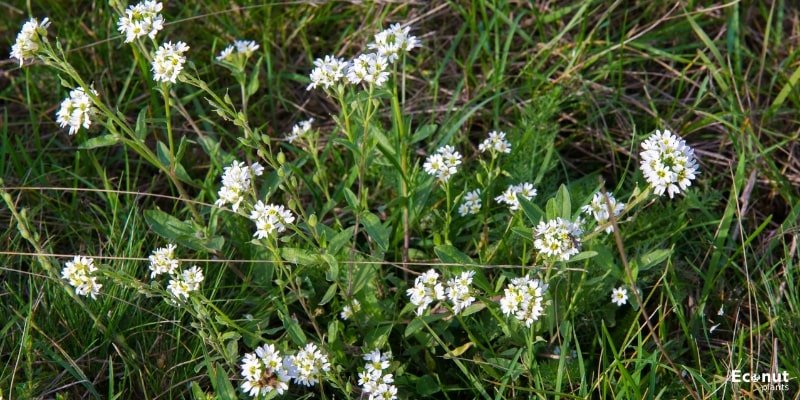
Growing large, luxuriant cucumber plants that don’t produce any fruit can be annoying. Gardeners who don’t have enough native bees frequently struggle with flower pollination. Known for its delicate and lovely white bloom, sweet alyssum attracts hard-working pollinators and predatory insects, which can maximize cucumber production.
Benefits: Attract helpful predatory insects and pollinators.
How to Plant It: Alyssum can be strewn around the bed or planted at each row’s end. More is always better! Cucumbers won’t compete with Alyssum because of its adaptability. Give cucumbers and alyssum plants a 10- to 12-inch gap.
5. Lettuce

When growing cucumbers on a trellis such as an A-frame trellis, cattle panel, or fence, lettuce is the ideal light-feeding companion. Cucumbers are unaffected, but lettuce benefits from the dappled shade, which keeps it from bolting in the summer heat.
Benefits: Make use of space.
How to Plant It: Plant lettuce in a single row, starting 8–10” from the base of the trellised cucumbers. Give each lettuce plant a 6- to 8-inch gap between heads. To help retain moisture and keep the soil cool, use mulch made of chipped leaves or straw.
6. Carrots

Carrots neutrally complement cucumbers, much like beets do. They do not benefit the crop in any way, but they do make use of the bare soil and dappled shade provided by the cucumber trellis.
Benefits: Make the most of the harvestable space.
How to Plant It: Carrots should be sown 12 to 16 inches from the base of a cucumber trellis at the same time as beets. Make sure the seeds are positioned on the side of the trellis facing south, and then thin them to a distance of one inch.
7. Sunflowers

Cucumber plants can be supported by sunflowers as a living trellis. Make sure the large sunflowers you select have robust stalks. In southern areas, the large blossom heads can shield cucumbers from the harsh summer heat.
Benefits: Living trellis with soft shadows.
How to Plant It: Grow exactly as the maize mixture mentioned above suggests.
8. Peas
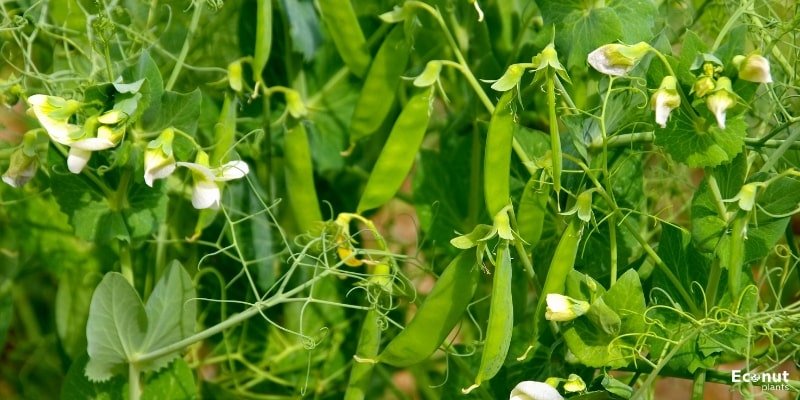
Legumes are a fantastic option for interplanting in your cucumber patch because cucumbers require a lot of nitrogen. With a cucumber trellis, summer field peas will enthusiastically vine alongside to add another crop that can be harvested from the area and increase nutrient availability at the same time.
Your cucumbers may access nitrogen because of the symbiotic interaction between the peas and soil microorganisms.
Benefits: Optimize space and raise the availability of nitrogen.
How to Plant It: The greatest trellis to run for vining various crops in a bed is from north to south. Plant the peas directly when you transplant the cucumbers.
Try interring planting pieces of cucumber with clusters of peas spaced about 2 inches apart. Keep a minimum of 6″ of space between the adjacent cucumber plants and the pea groups.
9. Borage

The stunning blue flowers, like little stars, are borne on this deer-resistant plant. Borage has a benevolent effect both above and below the surface. They work wonders at keeping armyworms, cabbage loopers, and bothersome wireworms away from cucumber plants.
In addition, their blossoms attract pollinators and pest-eating predators, which will boost your cucumber fruit production. Moreover, borage is a bioaccumulation. Its deep roots are believed to draw essential trace minerals out of the earth, making them accessible to cucumber plants with shallow roots.
Benefits: Promote development, sequester pests, store nutrients, and draw in helpful predatory insects.
How to Plant It: Plant borage at the ends of rows or along garden borders, as these plants may get very huge when in full bloom. Borage can be planted 10–12 inches from the trellis base on the bed’s sunny southernmost section if you’re trellising cucumbers.
10. Calendula

Calendula species, sometimes called “pot marigold,” are a distinct class of daisy-family plants with fragrant, resinous flowers in a range of vivid colours.
Calendula’s exceptionally high pollen concentration attracts bees, butterflies, lacewings, hoverflies, and pest-eating insects. It thrives in challenging soil conditions and makes a great companion plant.
Benefits: Draw in beneficial pollinators and predators.
How to Plant It: You can plant calendula all around your garden, even between plantings of cucumbers every 6 to 12 inches. They grow well along trellised cucumber rows, provided they are not shaded out.
Remember to distribute the dried calendula seed heads to maintain the patch’s growth. The “C”-shaped seeds are also simple to save for the following year.
11. Oregano

This hot Italian herb goes well with almost any vegetable, but cucumbers particularly benefit from its presence. Its fragrant, peppery leaves deter squash bugs and aphids that feed on sap.
When permitted to flower, the striking purple blossoms provide a home and food source for lacewings and other beneficial insects. The larvae of lacewings are voracious eaters that target cabbage looper eggs, flea beetles, and aphids!
Benefits: Draw in helpful predators while warding off pests.
How to Plant It: Kitchen and garden use for oregano are as diverse. Keep a distance of roughly 14–18 inches between it and nearby crops when planting it in borders or around the corners of an elevated bed. When it receives enough sunlight, its low-growth habit goes well with trellised cucumbers.
12. Chrysanthemum
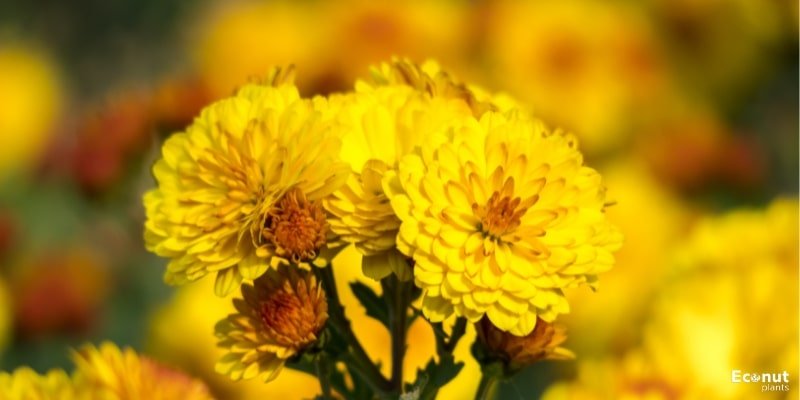
The initial “natural pesticide” that served as the model for contemporary organic pyrethrum sprays was chrysanthemums.
By upsetting the nerve systems of insects, this naturally occurring substance deters spider mites, cucumber beetles, squash bugs, and other pests, causing them to become disoriented and confused as they attempt to eat your crops.
As an alternative, you can make your DIY pyrethrum spray by soaking chrysanthemum flower heads in water with a teaspoon each of soap and oil.
Benefits: Pest-repelling natural pesticide.
How to Plant It: Chrysanthemums grow well outside of annual vegetable gardens since they are herbaceous perennial shrubs. To reap their benefits year after year, plant them near your cucumber beds in border margins.
13. Dill
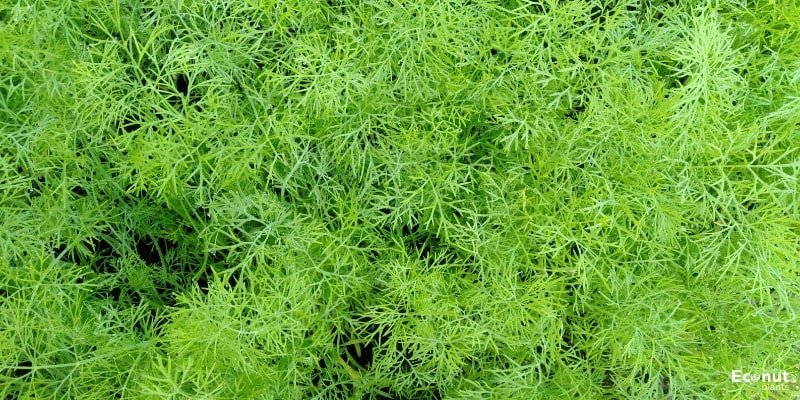
Dill and cucumbers are a classic combination that works well in pickles and the garden. A remarkable variety of parasitic wasps, ladybirds, hoverflies, and other predators of aphids, mites, thrips, and cucumber beetles are drawn to the large umbel blossoms of dill.
Additionally, seasoned gardeners anecdotally state that immature dill plants promote the growth of nearby crops.
Benefits: Boost growth and draw in beneficial insects.
How to Plant It: It is optimal to sow dill in the garden at the same time as cucumbers. Allow the plants to bolt in the summer heat and keep them 12–16 inches away from nearby cucumbers. Harvest the leaves and flowers often to provide ongoing herbal goodness for salads and pickles.
14. Marigolds

Marigolds, popular during Dia de los Muertos (Day of the Dead) festivities for their vivid orange and yellow hues, are also very powerful insect repellent. Aphids and cucumber beetles are turned off by their musky floral scent and sticky, resinous flowers, which also deter ravenous bunnies.
They attract helpful predators like ladybirds to hunt down pests for you, and they bloom throughout the season.
Benefits: Draw in helpful predators and drive away pests.
How to Plant It: Plant marigolds in the garden at the same time as cucumbers in the early spring, allowing 8 to 10 inches between them and other plants. African marigolds can grow very large, so make sure you have sturdy French marigolds.
15. Pole Beans
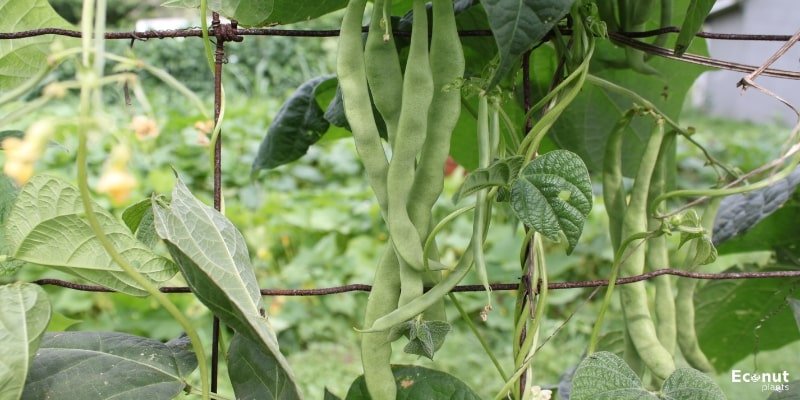
Pole beans, like vining peas, fix nitrogen and grow on a trellis next to cucumbers without crowding out the latter for light or space. Remember that this combination works best when trellising cucumbers upward.
Benefits: Maximize space and fix nitrogen.
How to Plant It: Maximize space and fix nitrogen.
16. Onions

The natural enemies of aphids, Japanese beetles, and rabbits are alliums, regardless of variety. Cucumbers benefit greatly from the strong scent and growing habit of onions in particular. Cucumbers cannot outcompete them for light, water, or fertility because of their shallow roots and low growth habits.
Benefits: Deter vermin and increase cultivable area.
How to Plant It: Starting or setting in a row, transplant onions are spaced 4-6″ apart from trellised cucumber plants. When cucumbers are growing along the ground, don’t pair them together since the onions will overgrow them.
17. Nasturtiums

Aphids, squash bugs, and cucumber beetles are all repelled from gardens by the vivid flowers and foliage of nasturtiums. To keep aphids in check, they also attract hoverflies, other pollinators, and predators.
Their edible blossoms are also a delightfully spicy garnish for summertime foods. One thing to keep in mind while using nasturtiums is that they can also be used as a “trap crop.”
The nasturtium plants are commonly the target of pests drawn from your crop; if these pests start to establish a home for harmful insects, you may need to get rid of them.
Benefits: Attract pollinators, draw beneficial insects, and drive away pests.
How to Plant It: Nasturtiums require lots of space from your cucumbers; they can be large shrubs or climbing vines. In each bed, plant two or three cucumber plants, keeping a minimum of one foot between each one.
Planting them in between cucumber plants helps. When planting nasturtiums in smaller places, you can choose a tiny variety or let them climb a cucumber trellis.
There’s no need to water or fertilize these flowers because they thrive on neglect. Another excellent choice for container gardeners is hanging baskets.
What Not to Plant with Cucumbers
Even though cucumbers are a reasonably laid-back plant, some plants in the garden are better kept out of the way. Any of these unwanted neighbours can lead to a variety of frequent problems when growing cucumbers. Keep these away from your cucumber bed:
Melons, Zucchini, and Squash
The same insect and disease issues that affect cucumbers also affect other members of the cucurbit family, such as cantaloupe and zucchini. As part of a seasonal crop rotation, plant them in other garden sections.
Potatoes
Cucumbers don’t go well with potatoes because of their bushy growth and hilly requirements. Potatoes aren’t the best friends, but they also aren’t the worst. To reap the benefits that each plant offers, it is important to plant companion plants.
Mint
This is a highly invasive herb that may quickly take over a bed and ruin your cucumber flavour. Although similar to potatoes, they go well with cucumbers, mint isn’t the greatest and can be difficult to maintain if not handled properly.
Brassicas
Cauliflower, broccoli, cabbage, kale, and their relatives are heavy feeders and famously thirsty plants. They fight for nutrients, water, and space. Some of the same pests that affect cucumbers can also be drawn to them.
Sage
Sage may inhibit the growth of cucumbers, according to some data. Hence, consider other plants before choosing sage as a companion plant, even though it can be a powerful insect and wildlife repellent.
Fennel
Being an allelopathic plant, fennel emits substances into the soil that prevent other plants from growing nearby.
Conclusion
Cucumbers are tasty, robust, and easy-going plants that will gladly yield cool fruits till the first frost. Companion plants are the best way to maximize your space, improve pollination, and fend off pesky pests like cucumber beetles. Now that you know exactly what to grow with cucumbers this season, it’s time to get planting!

